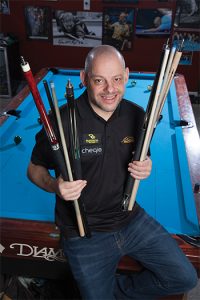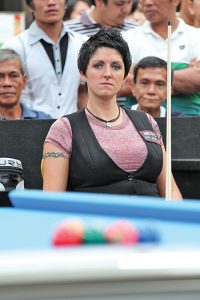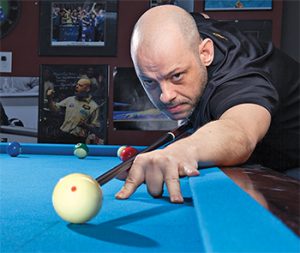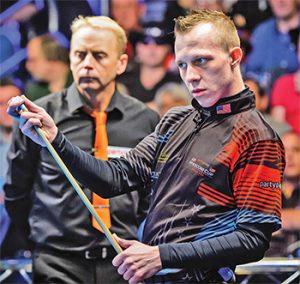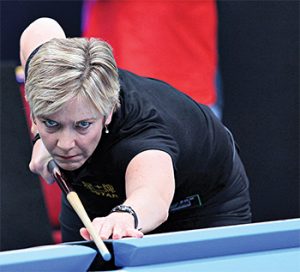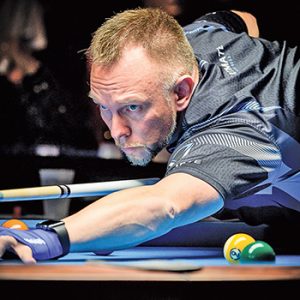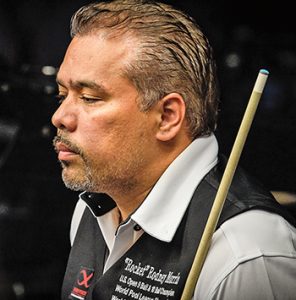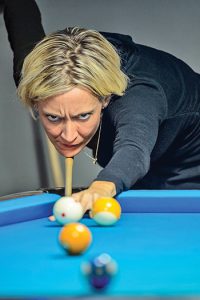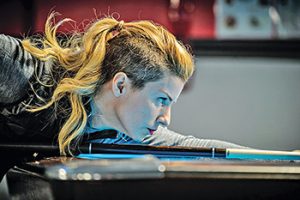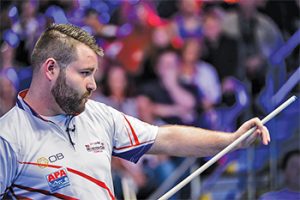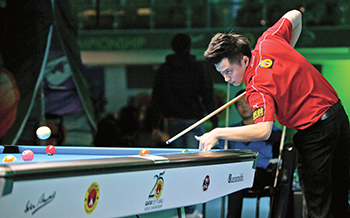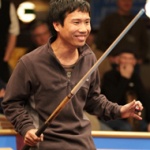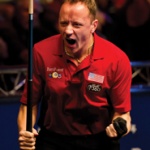Teams Set For Mosconi Cup
With the announcement of the final “wildcard” selections by the opposing captains, the final rosters for Team USA and Team Europe are set with four weeks to go before the 23rd Mosconi Cup commences at the Alexandra Palace in London, Dec. 6-9.
Team USA captain Mark Wilson used his wildcard picks to add Mosconi Cup veteran and recent Billiard Congress of America Hall of Fame inductee “Rocket” Rodney Morris and 29-year-old Justin Bergman to the roster. It will mark the tenth Mosconi appearance for Morris and the third consecutive appearance by Bergman. The duo will join Shane Van Boening, Skyler Woodward and Mike Dechaine, who earned automatic spots on the team by finishing in the top three in points over 28 tournaments throughout the year. Only Morris did not play on the 2015 team that fell to Team Europe, 11-8, in Las Vegas. (Corey Deuel was the fifth member of Team USA in 2015.)
Team Europe captain Marcus Chamat handpicked reigning World 9-Ball Champion Albin Ouschan of Austria and England’s Darren Appleton, who will be making his eighth consecutive appearance, to join Holland’s Niels Feijen, Scotland’s Jayson Shaw and England’s Mark Gray. The three automatic berths on Team Europe were awarded to the points champion of the EuroTour (Feijen), the top European points earner on a World Events Rankings (Shaw), and the highest-ranked player on the Combined (Gray, who placed third behind already-qualified Shaw and Feijen). Feijen, Appleton and Ouschan also appeared for Team Europe in 2015.
As is customary, the wildcard announcements were greeted by second-guessing in social media. American fans questioned Wilson’s selection of Bergman, ranked sixth on the U.S. points list, over fifth-place finisher Oscar Dominguez. (Morris finished fourth in points.) Given the fact that the 2015 squad was made up of the top five point-earners, and the fact that Bergman lives in southern Illinois, not far from Wilson’s St. Louis home, charges of favoritism and “politics” were bandied about as fans weighed in. “I don’t have a bias and I don’t give those claims any credence,” said Wilson. “I simply picked the team that I thought gave us the best chance of winning this year. I analyze things like late-season performance, strengths and weaknesses and how they fit in with the strengths and weaknesses of the rest of the team.
“In the case of Rodney,” Wilson continued, “He went to the last six events. The effort and results were there. He gives us the best chance of winning.Last year it just happened that the team I chose finished one through five in points. That doesn’t mean that is the way it was meant to be. People seem to have a hard time with the concept of what the wildcard pick means.”
The concept of a “wildcard” selection was even more pronounced in Chamat’s selection of Appleton for Team Europe. While the former World 9-Ball Champion has been a member of six Mosconi Cup-winning squads, Appleton suffered through a subpar 2016, failing to crack the top 10 in the European Combined points list.
“No player really stood out for me for the last spot,” said Chamat. “There are so many good players in Europe, but I had to weigh the ups and downs. Darren is a big-match player with huge experience. And he is an awesome team player. I could have picked other players, but I believe in Darren. This is the biggest event for all of us and the pressure will be amazing. I think Darren will be amazing, too.”
Wilson Names Team USA Hopefuls
 As was his original intent, Mosconi Cup Team USA Captain Mark Wilson worked quickly to select the players who will compete for the final five roster spots for the 2014 event in December in Blackpool, England. Wilson announced the selection of eight players who will train and compete together through the summer, before the captain whittles the list down to the five players who will wear the red, white and blue in Blackpool.
As was his original intent, Mosconi Cup Team USA Captain Mark Wilson worked quickly to select the players who will compete for the final five roster spots for the 2014 event in December in Blackpool, England. Wilson announced the selection of eight players who will train and compete together through the summer, before the captain whittles the list down to the five players who will wear the red, white and blue in Blackpool.
Not surprisingly, Wilson tabbed America’s No. 1, Shane Van Boening, and immediately announced that he will expect the taciturn star to provide leadership to the 2014 squad. “Shane sets a great example,” Wilson said in a press release. “And I expect to rely on him for leadership this year.”
Wilson also named seven-time Mosconi Cup veteran Corey Deuel, who many thought should have been on the team in 2013, to the squad. John Schmidt, Oscar Dominguez and Brandon Shuff, each of whom has participated in one Mosconi Cup, were named to the team was well. Leaning on America’s youth, Wilson rounded out his selection with Southern Classic One-Pocket champion Justin Bergman, Derby City titlist Justin Hall and Connecticut’s Jeremy Sossei.
“I’m really excited by this team,” Wilson said. “Every player seems so genuinely appreciative and excited. They’re all willing to do whatever it takes to develop a strong team and a strong sense of unity.”
More interesting than who Wilson selected, of course, was the list of players who weren’t invited to “camp.” The most notable omission was Johnny Archer, whose string of 17 consecutive Mosconi Cup appearances will come to an end. Fourteen-time Cup participant Earl Strickland and nine-time team member Rodney Morris were also left off the roster. In fact, Van Boening will be the only holdover from the 2013 squad that lost 21-1 to Team Europe in Las Vegas.
“I didn’t interview those players,” Wilson admitted. “And I explained to Johnny that I thought it best to go in a completely different direction this year. A lot of it is about attitude. Last year I felt there was no sense of urgency. There seemed to be a sense that it was a yearend bonus, and if the team won, great.”
Another player conspicuous by his absence is Mike Dechaine, one of the most consistent American players over the past three years.
“I spoke to Mike,” said Wilson. “In the end I felt that his reputation among the players wasn’t a good fit at this stage for a team event like the Mosconi Cup.”
Wilson added that his plan is to get the players together several times over the summer and fall for practice and team bonding. Wilson said he planned to make the final cut to five players after the U.S. Open, and that Team USA would meet and practice together for a week at Lindenwood University near St. Louis before departing for London. The dates of the 2014 Mosconi Cup are Dec. 1-4.
DCC 9-Ball: Alex Roars in Final
Dechaine, fresh off a dominant 9-2 victory over Shane Van Boening, kept pace with Pagulayan. With the 9-ball event extending races to nine racks, a change to meet BCA-mandated specifications for points events, Pagulayan and Dechaine met on the hill, 8-8. Following an exchange of safeties, the Filipino hit a table-length kick on the 1 ball on his way out, securing his spot alongside Putnam.
And while Putnam kept pace with Pagulayan, the Lion proved too much for the 41-year-old American. After Putnam closed to within a rack at 7-6, Pagulayan forced his opponent to foul in each of the next two racks to take the $16,000 title by a final count of 9-6.
With that victory, Pagualayn capped the 15th Derby City Classic where the majority of the big prizes went to the always-formidable Filipino contingent. Francisco Bustamante, winner of the banks division and runner-up to Corey Deuel in one-pocket, took home the $20,000 Master of the Table all-around award. Dennis Orcollo, meanwhile, snapped off the Bigfoot 10-Ball Challenge to pocket the $20,000 first prize.
ESPN to Stream Mosconi Cup
Just hours before the 2012 Mosconi Cup kicks off in London, Matchroom Sport announced that ESPN will broadcast all of the action live on its ESPN3 network. Here is the full release from Matchroom Sport:
With the 2012 PartyPoker.com Mosconi Cup set to start at 2 Eastern time on Monday 10th December, pool fans across America will be able to follow all the action live on ESPN 3 as Team USA goes in search of Team Europe’s crown.
Taking place at the legendary York Hall in East London between Monday 10th and Thursday 13th December, this is the 19th annual running of pool’s biggest event as two five man teams from the USA and Europe go at it over four days of sheer adrenalized 9 ball action.
Team USA are aiming to win back the trophy they last won at MGM Grand in 2009. The Europeans retained their trophy in Vegas 12 months ago, defeating USA 11-7 in Vegas.
Captained by CJ Wiley, Team USA members Johnny Archer(Georgia), Shane Van Boening (South Dakota), Dennis Hatch (New York) and Mike Dechaine (Maine) are joined by rookie Brandon Shuff (Virgina) for Mosconi Cup XIX.
ESPN3 is ESPN’s multi-screen sports network, a live destination that delivers thousands of sports events annually and accessible online at WatchESPN.com, on smartphones and tablets via the WatchESPN app and through ESPN on Xbox LIVE to Gold members. It is currently available to 79 million homes at no additional cost to fans who receive their high-speed Internet connection or video subscription from an affiliated service provider. The network is also available at no cost to approximately 21 million U.S. college students and U.S.-based military personnel via computers connected to on-campus educational networks and on-base military networks.
Team USA Set for Mosconi Cup
Following from his undefeated run through last week’s U.S. Open 9-Ball Championship, Shane Van Boening cemented his place at the head of the American 2012 PartyPoker.com Mosconi Cup rankings to secure his spot on the team as one of the top two automatic spots.
“I’m so happy to be on my sixth appearance as Mosconi USA team member,” Van Boening said. “As I just won the U.S. Open, I know I’m playing well this year and will try my best to help the team take home the title.”
Such was Van Boening’s dominance of the five-event series that he beat the second placed player Mike Dechaine by an incredible 218 points. In his previous five Mosconi Cup appearances, the South Dakota Kid sports a record of 12 wins from 26 matches.
For second placed Dechaine it will be a return to the team following on from his debut in Las Vegas last year and he will be relishing the chance to show what he can do in front of a partisan, sold-out crowd at the York Hall, London, from December 10-13.
“I am very excited to compete in my second consecutive Mosconi Cup, especially with this one being in London,” Dechaine said. “With the crowds being heavily in Europe’s favor, this is without a doubt the team I’d want going against it.”
The first of the remaining three wildcard picks is Virginia’s Brandon Shuff, who caps off a fine season to make his Mosconi Cup debut at the age of 29.
“When I was growing up, it was an American pool player’s dream to play on the Mosconi Cup,” he said. “This is definitely a blessing and hard work is paying off and I’m excited for this accomplishment and I’ll be training hard to help our team bring that Cup back where it belongs.”
Back for his third Mosconi Cup is Dennis Hatch. An MVP in his 2009 debut when his gung-ho team spirit helped propel the team to victory, Hatch will be hoping for a successful return to the York Hall where he made his last Mosconi Cup appearance in 2010.
“It’s always an honor and privilege to represent the US,” he said. “I am so fired up and hungry that the only thing I plan on tasting while in Europe is victory, because I believe this is one of the best teams yet.”
The final spot in the team is filled by Georgia’s Johnny Archer who will be making a record-breaking 16th consecutive Mosconi Cup appearance. With a winning percentage of 53, the Scorpion made his debut at the event in 1996 and has been an ever-present since.
“It is an honor to represent the USA team for my 16th straight year,” he said. “And I will do whatever it takes to help the boys take that cup from York Hall and bring it back to America where it belongs.”

